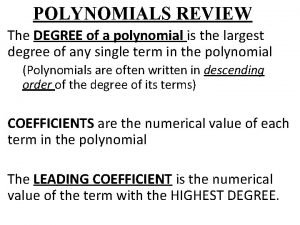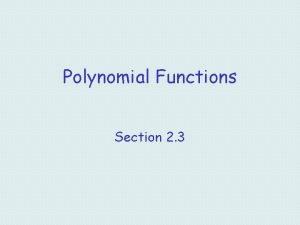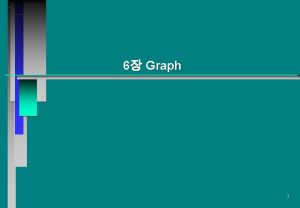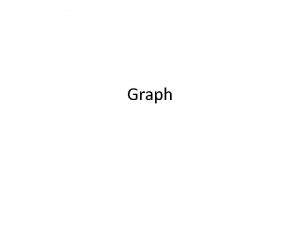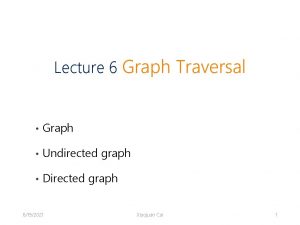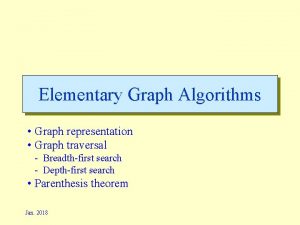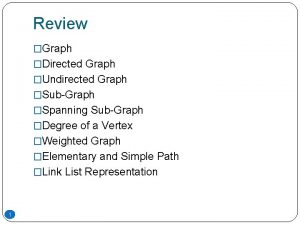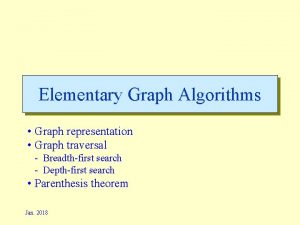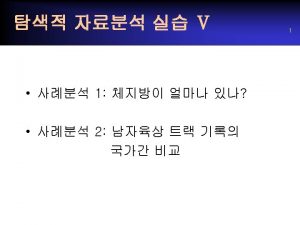Degree sequence The Degree Sequence of a graph




















- Slides: 20

Degree sequence • The Degree Sequence of a graph is the list of vertex degrees, usually written in nonincreasing order, as d 1 …. d n. • Example: x w v y Degree sequence: d(w), d(x), d(y), d(z), d(v) z 1

Proposition 13: The nonnegative integers d 1 , …, dn are the vertex degrees of some graph if and only if di is even. Proof: Necessity • When some graph G has these numbers as its vertex degrees, the degree-sum formula implies that di = 2 e (G), which is even. 2

Proposition 13: The nonnegative integers d 1 , …, dn are the vertex degrees of some graph if and only if di is even. Proof: Sufficiency • Suppose that di is even. • We construct a graph with vertex set v 1, …, vn and d(vi) = di for all i. • Since di is even, the number of odd values is even. • First form an arbitrary pairing of the vertices in {vi : di is odd}. • For each resulting pair, form an edge having these two vertices as its endpoints • The remaining degree needed at each vertex is even and nonnegative; satisfy this for each i by placing [di /2] loops at vi 3

Graphic Sequence • A graphic sequence is a list of nonnegative numbers that is the degree sequence of some simple graph. • A simple graph “realizes” d. • means: A simple graph with degree sequence d. 4

Recursive condition • The lists (2, 2, 1, 1) and (1, 0, 1) are graphic. The graph K 2+K 1 realizes 1, 0, 1. • Adding a new vertex adjacent to vertices of degrees 1 and 0 yields a graph with degree sequence 2, 2, 1, 1, as shown below. • Conversely, if a graph realizing 2, 2, 1, 1 has a vertex w with neighbors of degrees 2 and 1, then deleting w yields a graph with degrees 1, 0, 1. 2 1 K 2 1 2 0 K 1 1 1 5

Recursive condition • Similarly, to test 33333221, we seek a realization with a vertex w of degree 3 having three neighbors of degree 3. Delete this Vertex A new degree sequence 33333221 2223221 6

Recursive condition This exists if and only if 2223221 is graphic. (See next page) • We reorder this and test 3222221. • We continue deleting and reordering until we can tell whether the remaining list is realizable. • If it is, then we insert vertices with the desired neighbors to walk back to a realization of the original list. • The realization is not unique. (EXERCISE !) • The next theorem implies that this recursive test works. 7

Recursive condition 33333221 2223221 3222221 111221 221111 10111 11110 8

Necessary and Sufficient Condition for a Sequence to be the Degree Sequence of a Simple Graph • Proposition 14: For n>1, an integer list d of size n is graphic if and only if d’ is graphic, where d’ is obtained from d by deleting its largest element and subtracting 1 from its next largest elements. The only 1 -element graphic sequence is d 1=0. 9

Proposition 14: For n>1, an integer list d of size n is graphic if and only if d’ is graphic, where d’ is obtained from d by deleting its largest element and subtracting 1 from its next largest elements. The only 1 -element graphic sequence is d 1=0. Proof: 1/6 • For n =1, the statement is trivial. • For n >1, we first prove that the condition is sufficient. • Given d with d 1 …. . dn and a simple graph G’ with degree sequence d’ For Example: We have: 1) d = 33333221 2) G’ with d’ = 2223221 G’ We show: d is graphic 10

Proposition 14: For n>1, an integer list d of size n is graphic if and only if d’ is graphic, where d’ is obtained from d by deleting its largest element and subtracting 1 from its next largest elements. The only 1 -element graphic sequence is d 1=0. Proof: 2/6 • We add a new vertex adjacent to vertices in G’ with degrees d 21, …. . , d +1 -1. • These di are the largest elements of d after (one copy of) itself, • Note : d 2 -1, …. . , d +1 -1 need not be the largest numbers in d’ (see example in previous page) G’ d : d 1, d 2, … dn d’ : d 2 -1, …. . , d +1 -1, … dn New added vertex May not be the largest numbers 11

Proposition 14: For n>1, an integer list d of size n is graphic if and only if d’ is graphic, where d’ is obtained from d by deleting its largest element and subtracting 1 from its next largest elements. The only 1 -element graphic sequence is d 1=0. • To prove necessity, 3/6 • Given a simple graph G realizing d , we produce a simple graph G’ realizing d’ • Let w be a vertex of degree in G, and let S be a set of vertices in G having the “desired degrees” d 2, …. . , d +1 w d : d 1, d 2, …d , d +1, … dn d 1= S: vertices 12

Proposition 14: For n>1, an integer list d of size n is graphic if and only if d’ is graphic, where d’ is obtained from d by deleting its largest element and subtracting 1 from its next largest elements. The only 1 -element graphic sequence is d 1=0. Proof: continue 4/6 • Case 1: If N(w)=S. Then we delete w to obtain G’. w d : d 1, d 2, …d , d +1, … dn d 1= Vertices, N(w)=S i. e. They are joined to w Delete w than we have d’ : d 2 -1, …. . , d +1 -1, … dn 13

Proposition 14: For n>1, an integer list d of size n is graphic if and only if d’ is graphic, where d’ is obtained from d by deleting its largest element and subtracting 1 from its next largest elements. The only 1 -element graphic sequence is d 1=0. Proof: continue 5/6 • Case 2: Otherwise, N(w) S (Recall that |N(w)| = = |S|. ) • Some vertex of S is missing from N(w). • In this case, we modify G to increase |N(w) S| without changing any vertex degree. • Since |N(w) S| can increase at most times, repeating this converts G into another graph G* that realizes d and has S as the neighborhood of w. • Now G* satisfies Case 1. So, from G* we then delete w to obtain the desired graph G’ realizing d’. w d : d 1, d 2, …d , d +1, … dn d 1= Vertices, N(w) S i. e. Some vertices are not joined to w. - We make them become joined to w without changing their degree. 14

Proposition 14: For n>1, an integer list d of size n is graphic if and only if d’ is graphic, where d’ is obtained from d by deleting its largest element and subtracting 1 from its next largest elements. The only 1 -element graphic sequence is d 1=0. Proof: continue 6/6 • To find the modification when N(w) S , we choose x S and z S so that w z are joined and w x are not. • We want to add wx and delete wz, but we must preserve vertex degrees. Since d(x) d(z) and already w is a neighbor of z but not of x, there must be a vertex y adjacent to x but not to z. Now we delete {wz, xy} and add {wx, yz} to increase |N(w) S|. w z y x This y must exist. w z y x It, i. e. x becomes joined to w 15

2 -switch • A 2 -switch is the replacement of a pair of edges xy and zw in a simple graph by the edges yz and wx, given that yz and wx did not appear in the graph originally. 16

Graphs with the Same Degree Sequence Proposition 15: If G and H are two simple graphs with vertex set V, then d. G(v)=d. H(v) for every v V if and only if there is a sequence of 2 -switches that transforms G into H. 17

Proposition 15: If G and H are two simple graphs with vertex set V, then d. G(v)=d. H(v) for every v V if and only if there is a sequence of 2 -switches that transforms G into H. Proof: (1/3) • Every 2 -switch preserves vertex degrees, so the condition is sufficient. • Conversely, when d. G(v)=d. H(v) for all v V , we obtain an appropriate sequence of 2 -switches by induction on the number of vertices, n. • If n<3, then for each choice of d 1, …. . , dn there is at most one simple graph with d(vi)=di. • Hence we can use n=2 as the basis step. 18

Proposition 15: If G and H are two simple graphs with vertex set V, then d. G(v)=d. H(v) for every v V if and only if there is a sequence of 2 -switches that transforms G into H. Proof (2/3) • Consider n 3 , and let w be a vertex of maximum degree, • Let S={v 1, …. . , v } be a fixed set of vertices with the highest degrees other than w • Some sequence of 2 -switches transforms G to a graph G* such that NG*(w)=S, and some such sequence transforms H to a graph H* such that NH*(w)=S • Since NG*(w)=NH*(w), deleting w leaves simple graphs G’=G*-w and H’=H*-w with d. G’(v)=d. H’(v) for every vertex v 19

Proposition 15: If G and H are two simple graphs with vertex set V, then d. G(v)=d. H(v) for every v V if and only if there is a sequence of 2 -switches that transforms G into H. Proof (3/3): • By the induction hypothesis, some sequence of 2 switches transforms G’ to H’. Since these do not involve w, and w has the same neighbors in G* and H*, applying this sequence transforms G* to H*. • Hence we can transform G to H by transforming G to G*, then G* to H*, then (in reverse order) the transformation of H to H*. 20
 Polynomial review
Polynomial review How to find the degree of a polynomial graph
How to find the degree of a polynomial graph First degree price discrimination
First degree price discrimination Second degree price discrimination graph
Second degree price discrimination graph How to tell if a polynomial is positive or negative
How to tell if a polynomial is positive or negative Global clustering coefficient
Global clustering coefficient Hình ảnh bộ gõ cơ thể búng tay
Hình ảnh bộ gõ cơ thể búng tay Ng-html
Ng-html Bổ thể
Bổ thể Tỉ lệ cơ thể trẻ em
Tỉ lệ cơ thể trẻ em Voi kéo gỗ như thế nào
Voi kéo gỗ như thế nào Chụp phim tư thế worms-breton
Chụp phim tư thế worms-breton Hát lên người ơi
Hát lên người ơi Các môn thể thao bắt đầu bằng tiếng bóng
Các môn thể thao bắt đầu bằng tiếng bóng Thế nào là hệ số cao nhất
Thế nào là hệ số cao nhất Các châu lục và đại dương trên thế giới
Các châu lục và đại dương trên thế giới Công thức tính độ biến thiên đông lượng
Công thức tính độ biến thiên đông lượng Trời xanh đây là của chúng ta thể thơ
Trời xanh đây là của chúng ta thể thơ Cách giải mật thư tọa độ
Cách giải mật thư tọa độ Làm thế nào để 102-1=99
Làm thế nào để 102-1=99 Phản ứng thế ankan
Phản ứng thế ankan
